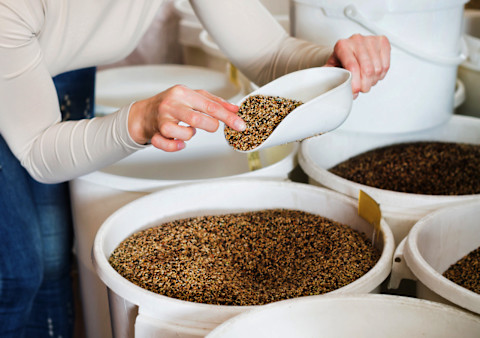
I ate my first cricket on a hot summer's day in 2014. Part of a "taste the world" food court, it was slightly salty, very crunchy, and coated in chocolate. I found the texture off-putting and forced it down with some water, gave the vendor a polite smile, and walked away confident that would be the last time I'd indulge in an insect.
Little did I know that at the time, a quiet bug revolution was starting to brew in the Western world. Over the last few years, "insect farms" opened across America, bug-eating festivals enticed curious young eaters, and The Insect Cookbook hit shelves. The Economist sent out food trucks loaded with mealworm-covered waffles and ice cream, and experimental restaurants worldwide added tiny critters to menus. Bugs have become an ingredient in everything from chips to energy bars, and Whole30 founder Melissa Hartwig even told mindbodygreen that she fuels up with Chapul Cricket protein shakes on gym day. "I don’t eat whey, soy, or plant protein, and the Chapul stuff is low-sugar and protein dense (and yes, it tastes great—you’d never know you were eating bugs)," admitted the wellness it-girl. It all raises the buggy question: Are insects poised to become a go-to protein source?
The environmental case for bugs.

Insect proteins tend to be easier on the planet than traditional livestock and could therefore help feed a growing world. The United Nations has embraced them as a viable solution to the agricultural dilemmas we're already facing, declaring "To meet the food and nutrition challenges of today—there are nearly 1 billion chronically hungry people worldwide—and tomorrow, what we eat and how we produce it needs to be re-evaluated. Inefficiencies need to be rectified and food waste reduced. We need to find new ways of growing food."
While there is a debate over how much better bug protein is for the environment than your hamburger or chicken breast, studies have conclusively found that bugs require less land and water to harvest. When compared to corn and soy, two of the most widely grown livestock crops, mealworms use about 0.2 percent as much land and a small fraction as much water, making them an appealing livestock feed alternative. Some producers are also starting to feed their critters food that would have otherwise been thrown away in an effort to cut down on food waste.
Furthermore, studies out of Thailand1 found that poultry farming causes 89 percent more greenhouse gas emissions, on average, than cricket growing. Compared to cows—which release 30 to 50 gallons of heat-trapping methane gas into the environment daily—bugs are even more appealing from a sustainability standpoint.
However, insect harvesting has its downside. Overexploiting certain regions can throw off the food chain and mess with the animals and people that depend on bugs for fuel (an estimated 2 billion people around the world are already eating them, after all). In Australia2, for instance, populations of honey ants and wood grubs—two essential edible insect species for Aboriginals—are now in due to increased demand from restaurants and for ecotourism sites.
Where the industry is headed.
While bug ag may not replace Big Ag anytime soon, more and more insect-inspired products are popping up on the mass market. Many of them use bug flour, which has a slightly nutty flavor and a texture that is more palatable to the everyday consumer. Here are a few brands packaging sustainable bug protein into a nutritious, and—dare we say?—delicious, package.
In your snack aisle.
The brainchild of three female Harvard students who experimented with bug protein in their dorm room, Chirps is a line of flavored chips made using crickets. Bitty foods, another women-led business, is a line of savory air-puffed chips inspired by Mexican chapulines that list cricket flour as No. 2 on their ingredient list.
In your protein shakes and bars.
EXO Protein combines cricket protein powder with dates and cocoa nibs for a gluten-free, dairy-free energy bar. "Most of the world has joined the bug-eating revolution—we’re here to convert the rest," its site reads. Meanwhile, food giants like PepsiCo have allegedly expressed interested in incorporating bug protein into its product line.
In your local restaurant.
Denver is one city leading the edible bug scene, and multiple local restaurants are working insects into menus to rave reviews. Jaqueline Perez, a chef at popular Mexican restaurant Comida, told GQ that within the first two days of having fried-cricket tacos on the menu, she sold out of 2 pounds of crickets. Could your city be next?
Curious what other out-there foods are about to have a moment? Check out Whole Foods' trend forecast for 2018, and check out the superfood mbg predicts is about to be everywhere.
